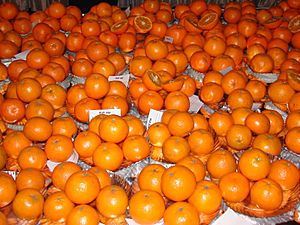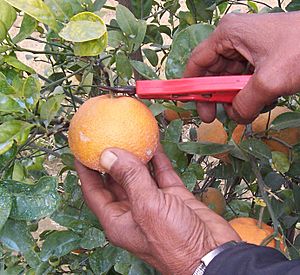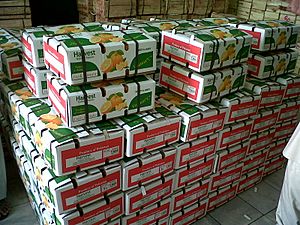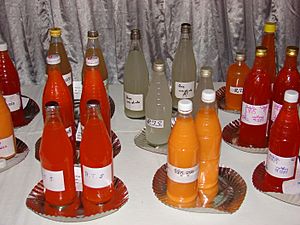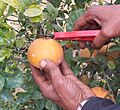Kinnow facts for kids
Quick facts for kids Kinnow |
|
|---|---|
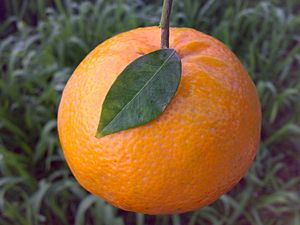
Kinnow, Courtesy by SMHT
|
|
| Hybrid parentage | 'King' (Citrus nobilis) × 'Willow Leaf' (Citrus × deliciosa) |
| Breeder | Howard B. Frost, University of California Citrus Experiment Station in 1935 |
The Kinnow is a special type of mandarin orange. It's a hybrid, meaning it's a mix of two different citrus fruits. This tasty orange is grown a lot in the Punjab region of India and Pakistan.
It was first created by a scientist named Howard B. Frost. He worked at the University of California Citrus Experiment Station. He mixed a 'King' orange (Citrus nobilis) with a 'Willow Leaf' orange (Citrus × deliciosa). The 'Kinnow' was introduced for growing in 1935.
Contents
What is a Kinnow?
Kinnow trees can grow quite tall, up to 35 feet (about 10.5 meters) in warm places. These trees are very productive. It's common to see a single tree grow as many as 1,000 fruits!
The fruit is usually ready to pick in January or February. Kinnow oranges are known for being easy to peel. They also have a lot of juice inside, making them great for eating or drinking.
Seedless Kinnow Oranges
One challenge with regular Kinnow oranges is that they have many seeds. This can make them a bit tricky to eat. Because of this, scientists have worked hard to create Kinnow varieties with fewer seeds.
For example, scientists in the USA and India have developed low-seed Kinnows. These new types make the fruit even more enjoyable. In Pakistan, a seedless Kinnow was also created. These efforts help more people enjoy this delicious fruit without the hassle of seeds.
Where are Kinnows Exported?
Most Kinnow oranges from India and Pakistan are sold to other developing countries. Only a small amount goes to developed countries. This is because developed countries often prefer seedless oranges. About 61% of all oranges and mandarins sold around the world are seedless.
Some of the main countries that buy Kinnow oranges include Iran, United Arab Emirates, Saudi Arabia, Indonesia, Malaysia, and Russia. In 2015, over 40% of Pakistan's Kinnow exports went to Russia.
Harvesting and Storing Kinnows
Kinnow trees are usually planted between August and October. The oranges are ready to harvest when their skin turns orange, usually from December to February. The best time to pick them is in mid-January to mid-February.
Workers pick the fruit carefully by clipping the stem with sharp tools called secateurs. They cut the stem very short. This helps prevent the fruit from getting damaged during packing and shipping. It's important not to pull the fruit by hand because its skin is a bit loose.
After harvesting, Kinnow oranges can be coated with special waxes. This helps them stay fresh for up to 60 days. They can also be stored in cold rooms. The best temperature for storage is about 4-5°C (39-41°F).
Processing Kinnow Fruit
When Kinnow oranges are processed, only the best quality fruits are chosen. A good Kinnow should feel firm but slightly soft. Its skin should be smooth, without deep grooves, and a deep orange color. People often use their hands to check for soft spots or dull colors.
Many ways to process Kinnow fruits have been developed. These methods help turn the oranges into different products. Kinnow fruits can be kept at room temperature or in cold storage.
Images for kids


